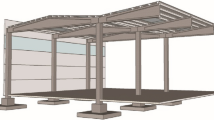Abstract
The cyclic behaviour of slender cantilever columns in full-scale models of precast industrial buildings, designed by Eurocode 8, was studied experimentally and analytically. The shear span ratio of the columns was 12.5, which is more than allowed by Eurocode 8 for columns in frame structures (10). High deformability and a large deformation capacity (8%~drift) of the columns was observed. A lumped plasticity model was used in the analysis. In the paper the observed behaviour of the models has been compared with the predicted behaviour obtained by several empirically based models and procedures. It was observed that these models, which were developed for much lower shear span ratios (2–6), were not applicable for the analyzed very slender columns without appropriate additional considerations and modifications. In the case of such columns the yield drift is dominated by the flexural mode (it is practically proportional to the height of the column) and the ultimate drift under cyclic loading conditions is only slightly dependent on the shear span (indicating that the ratio of the equivalent length of the plastic hinge to the height of the column decreases with the increasing shear span). An appropriately modified lumped plasticity model incorporating in-cycle and repeated-cycle strength deterioration was chosen for future use in performance-based design and seismic risk studies.
Similar content being viewed by others
References
Bindini F, Toniolo G (2004) Validation of seismic design criteria for concrete frames based on Monte Carlo simulation and full-scale pseudodynamic tests. In: Proceedings of the 13th world conference on earthquake engineering, Vancouver, BC, Canada, 1–6 August 2004
CEN (2004a) Eurocode 8: design of structures for earthquake resistance – Part 1: general rules, seismic actions and rules for buildings. CEN, Brussels
CEN (2004b) Eurocode 8: design of structures for earthquake resistance – Part 3: assessment and retrofitting of buildings. CEN, Brussels
Fardis MN, Biskins DE (2003) Deformation capacity of RC members, as controlled by flexure or shear. In: Kabeyasawa T, Shiohara H (eds) Performance-based engineering for earthquake resistant reinforced concrete structures: a volume honoring Shunsuke Otani, University of Tokyo, 8–9 September 2003
Haselton CB (2006) Assessing seismic collapse safety of modern reinforced concrete moment frame buildings. Dissertation, Stanford University
Ibarra LF, Medina RA, Krawinkler H (2005) Hysteretic models that incorporate strength and stiffness deterioration. Earthq Eng Struct Dyn 34(12): 1489–1511
Mander JB, Priestley MJN, Park R (1988) Theoretical stress–strain model for confined concrete. J Struct Eng 114(8): 1804–1826
OpenSees (2007) Pacific Earthquake Engineering Research Center, University of California, Berkeley. http://opensees.berkeley.edu. Cited 30 August 2007
Panagiotakos TB, Fardis MN (2001) Deformations of reinforced concrete members at yielding and ultimate. ACI Struct J 98(2): 135–148
Park R, Paulay T (1975) Reinforced concrete structures. Wiley, New York
Park R, Kent DC, Sampson RA (1972) Reinforced Concrete Members with Cyclic Loading. J Struct Div, ASCE 98: 1341–1360
Paulay T, Priestley MJN (1992) Seismic design of reinforced concrete and masonry buildings. Wiley, New York
PEER Structural Performance Database (2007) Pacific Earthquake Engineering Research Center, University of California, Berkeley. http://nisee.berkeley.edu/spd. Cited 30 August 2007
Peruš I, Fajfar P (2007) Prediction of the force-drift envelope for RC columns in flexure by the CAE method. Earthq Eng Struct Dyn 36: 2345–2363
Priesley MJN, Calvi GM, Kowalsky MJ (2007) Displacement based seismic design of structures. IUSS Press, Pavia
Takeda T, Sozen MA, Nielson NN (1970) Reinforced concrete response to simulated earthquakes. ASCE J Struct Div 96(12): 2557–2573
Toniolo G (coordinator) (2007) Final report of the EU Research Project: seismic behaviour of precast concrete structures with respect to EC8 (Contract No. G6RD-CT-2002-00857)
Tsoukantas SG, Tassios TP (1989) Shear resistance of connections between reinforced concrete linear precast elements.. ACI Struct J 86(3): 242–249
Author information
Authors and Affiliations
Corresponding author
Rights and permissions
About this article
Cite this article
Fischinger, M., Kramar, M. & Isaković, T. Cyclic response of slender RC columns typical of precast industrial buildings. Bull Earthquake Eng 6, 519–534 (2008). https://doi.org/10.1007/s10518-008-9064-7
Received:
Accepted:
Published:
Issue Date:
DOI: https://doi.org/10.1007/s10518-008-9064-7




